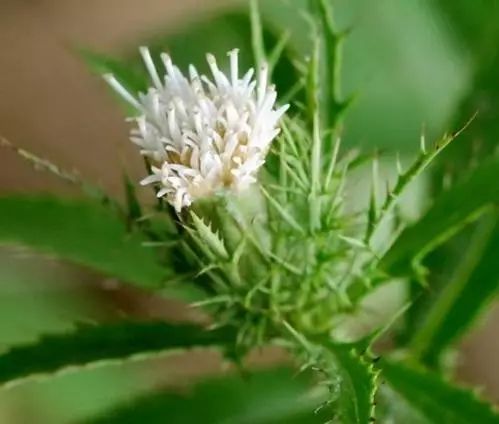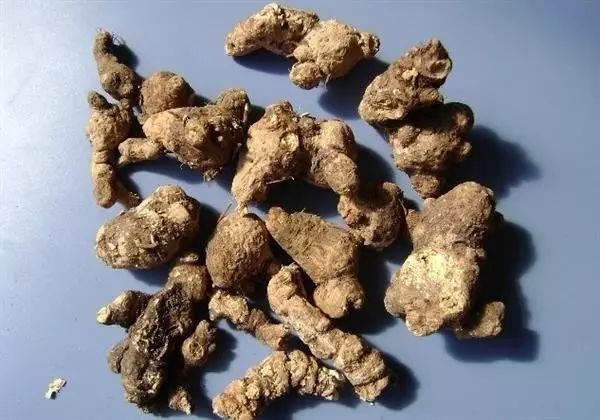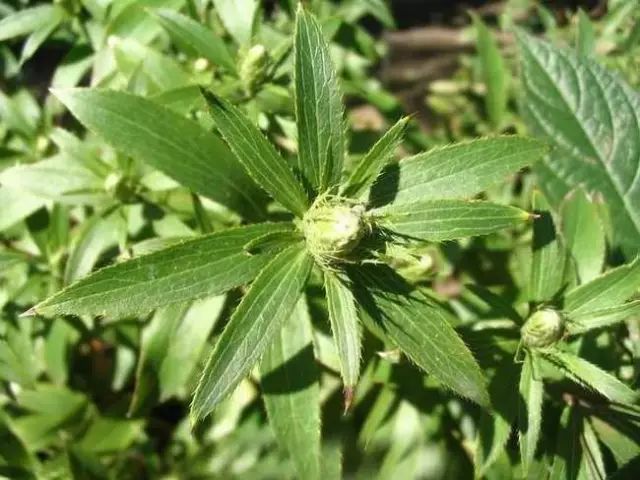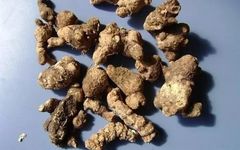
Cang Zhu (Atractylodes) has a pungent and bitter taste, and a warm nature. It is associated with the Spleen, Stomach, and Liver meridians. Its functions include drying dampness, strengthening the Spleen, dispelling wind, and alleviating cold, as well as improving vision. It is used for symptoms such as abdominal distension, diarrhea, edema, beriberi, rheumatic pain, wind-cold common cold, and night blindness.
Clinically, it is primarily indicated for fatigue and lethargy caused by dampness obstructing the Spleen and Stomach; abdominal distension; loss of appetite; nausea and diarrhea; phlegm-dampness; dampness and swelling; exterior syndrome with dampness; heaviness and pain in the head and body; rheumatic pain; and weakness.
The Legend of Cang Zhu
Once, there was a scholar named Xu, a title given to the renowned physician Xu Shuwei of the Song Dynasty. It is said that in his youth, Xu was exceptionally diligent, studying late into the night before going to bed. He had a habit of drinking alcohol before sleep, perhaps believing in the saying, “A sip of wine before bed can extend life to ninety-nine years!”
Years later, he often felt a gurgling sensation in his stomach, experienced pain in his side, and had a reduced appetite. Every ten to fifteen days, he would vomit a bitter and sour gastric fluid. In summer, only his right side would sweat while the left side remained dry. What kind of strange illness was this? Xu Shuwei fell into deep thought and sought treatment everywhere.
To his dismay, despite consulting many famous doctors, he found no relief, which caused him great distress. Thus, Xu abandoned the belief that “doctors cannot treat themselves” and began to save himself. He carefully analyzed his condition and concluded that his illness was primarily caused by “dampness obstructing the Stomach.”
Therefore, he adhered to his academic principle of “using precise medication” and selected Cang Zhu as the main herb, using one pound of Cang Zhu powder, fifteen jujubes, and half a tael of raw sesame oil to make small pills, taking fifty pills daily. He gradually increased the dosage to one hundred to two hundred pills per day. After several months of treatment, his strange illness gradually improved until he was completely cured.
The Efficacy of Cang Zhu
Why does Cang Zhu have such efficacy and a remarkable therapeutic effect on Xu Shuwei’s strange illness? It turns out that Xu had a fondness for drinking, which harmed his Spleen and Stomach. When the Spleen is deficient and unable to transport, dampness cannot be transformed, leading to “dampness obstructing the Stomach,” resulting in the gurgling sound in the stomach, lack of sweating on the left side in summer, and vomiting of gastric fluid.
The Spleen belongs to the Earth element, which prefers warmth and fragrance. Cang Zhu has an aromatic scent, a pungent and warm nature, and a bitter taste, and it is associated with the Spleen and Stomach meridians. The medicinal properties align perfectly, as Cang Zhu is aromatic and excels at awakening the Spleen and transforming dampness. Dampness is a Yin pathogen, which can be transformed when warmed.
Xu Shuwei’s accurate diagnosis and precise selection of herbs, using only one herb to achieve miraculous results, is noteworthy. It is also important to recognize that Xu’s insistence on long-term medication and gradually increasing the dosage was a well-considered strategy. He understood that dampness is sticky and difficult to eliminate quickly. Only by persisting with long-term medication and gradually increasing the dosage could the medicinal power accumulate in the body, ultimately overcoming dampness.

Treating Rheumatism
The primary efficacy of Cang Zhu is to strengthen the Spleen and eliminate dampness, and it can also dispel wind and alleviate cold. In Traditional Chinese Medicine, Cang Zhu is commonly used to treat rheumatism. In ancient times, rheumatism was referred to as “bi syndrome,” believed to be caused by a combination of wind, cold, and dampness. However, due to the warmer climate in the south, dampness can easily combine with heat, leading to different types of rheumatism. Regardless of the type, Cang Zhu can be used for treatment.
Here is a small formula: 30 grams of Cang Zhu, 10 grams of Gui Zhi (Cinnamon Twig), and 30 grams of Tou Gu Cao (Drynaria). Boil these three herbs together and use the decoction to soak the painful areas, or apply a towel soaked in the herbal juice to the painful areas for effective relief from pain caused by rheumatism.
Treating Diabetes
Diabetes, known in TCM as “Xiao Ke,” includes water-damp type, Yin deficiency type, and Spleen-Kidney Yang deficiency type. Patients with the water-damp type generally have a whitish tongue with a thin white coating; those with Yin deficiency type mainly present with a red tongue, thin and rapid pulse, thirst, and dry mouth; while those with Spleen-Kidney Yang deficiency type show pale complexion, cold limbs, and abdominal distension.
Cang Zhu is particularly suitable for patients with water-damp and Spleen-Kidney Yang deficiency types. Here is a specific formula for treating diabetes: 30 grams of Cang Zhu, 15 grams of Xuan Shen (Scrophularia), 30 grams of black sesame, and a bit of silkworm cocoon, decocted in water. The strong properties of Cang Zhu can be balanced by the Yin-nourishing effects of Xuan Shen, while silkworm cocoon has been used since ancient times to treat diabetes, and black sesame nourishes the kidneys. This combination is effective for treating diabetes.

Discussion on Cang Zhu’s Role in Strengthening the Spleen and Eliminating Dampness
In the Yuan Dynasty, Zhu Zhenheng stated: “Cang Zhu treats dampness, effective in all three regions (upper, middle, lower), and can resolve various stagnations, including phlegm, fire, dampness, food, qi, and blood stagnation, all caused by abnormal transformation and transportation, leading to diseases in the middle burner. Therefore, the medicine must address both ascending and descending functions; to ascend, one must first descend, and to descend, one must first ascend. Thus, Cang Zhu, as a foot Yangming Stomach meridian herb, with its pungent and strong flavor, invigorates the Stomach and strengthens the Spleen, promoting the qi of grains, and can directly enter various medicines…” This is indeed a profound insight. Liu Shouzheng of the Jin Dynasty also remarked: “Cang Zhu is a single herb that scholars should pay attention to,” indicating its broad efficacy. In my clinical practice, I have often used this herb and summarized its applications into four main points.
The functions and activities of the body’s organs depend on the Spleen and Stomach’s ability to transport and transform the essence of food and water. When the Spleen is strong, all organs are healthy; when the Spleen is weak, all organs are also weak, hence the saying, “The Spleen is the foundation of postnatal life.” Cang Zhu dries dampness without harming Yin; when dampness is eliminated, the Spleen becomes healthy, and when the Spleen is healthy, dampness is transformed. Therefore, in treating chronic diseases, the principle of “the Spleen governs the four organs” is paramount, and Cang Zhu is used as the monarch herb to invigorate the source of transformation and rejuvenation. For conditions like organ prolapse, hypokalemia, emphysema, and coronary heart disease, Cang Zhu is particularly effective in treating elderly patients with Spleen and Stomach diseases.
Ancient sages have said that it is better to strengthen the Spleen than to tonify it, and better to invigorate the Spleen than to strengthen it. When the Spleen’s function is invigorated, the generation of qi and blood is ensured. Therefore, ancient practitioners often used cooked Rehmannia with cardamom to tonify blood, and in nourishing and rich tonics, Cang Zhu is often added to prevent the cloying nature of tonics and promote the absorption of medicines. For example, in Gui Pi Decoction and Ren Shen Bai Du San, Cang Zhu is included to avoid the issue of fullness after taking the medicine. I once treated a patient with aplastic anemia who had previously been given strong tonics without improvement in blood counts. After adding Cang Zhu, the results were remarkable. Additionally, when used with cold and cool herbs, Cang Zhu can prevent damage to the Stomach, which is a clever application.
Phlegm and blood stasis are both sticky Yin pathogens, so to resolve phlegm and stasis, Yang qi must be mobilized. Cang Zhu excels at invigorating the Spleen and eliminating phlegm. To resolve blood stasis, qi must be moved, but based on the shared origin of phlegm and stasis and the Spleen’s governance over the four organs, Cang Zhu is often added to speed up the effect when there is long-standing stasis. For instance, using Cang Zhu in Ze Xie Decoction to treat ear-related dizziness, or in Ling Gui Zhu Gan Decoction to prevent and treat asthma, or decocting it alone for treating phlegm retention, diabetes, and night blindness, all have proven effective.
According to the principle of “the liver transmits to the Spleen, and one must first strengthen the Spleen” in treating liver diseases, I have also achieved significant results. I recall in the autumn of 1962, I had an acute liver disease, and aside from intravenous fluids, I was given greasy liver-protecting tonics, which resulted in dampness accumulation and phlegm retention, with frothy phlegm filling the bowl and transaminases rising to 500 units. I then applied Cang Zhu combined with Wu Ling San, and within a month, I recovered. I realized that strengthening the Spleen was more effective than merely protecting the liver. Over the years, I have treated many cases of liver disease with this principle, especially during the outbreak of hepatitis A in Shanghai, where all discharged patients were given Cang Zhu slices for follow-up, yielding satisfactory results.
The application of Cang Zhu should be skillfully combined; for those with severe cold-dampness, it is often used with Fu Zi (Aconite) and Rou Gui (Cinnamon); for damp-heat obstruction, it can be combined with Gan Lu Xiao Du Dan and Huang Lian; for damage to Stomach Yin, it can be paired with Shi Hu (Dendrobium), Xuan Shen, and Mai Dong (Ophiopogon); for damp-heat flowing through the meridians, it can be used with Shi Gao (Gypsum) and Gui Zhi; for liver Yang with dampness, leading to blurred vision and dry stools, it can be combined with black sesame; for qi deficiency, it can be supplemented with Huang Qi (Astragalus) and Sheng Ma (Cimicifuga). These combinations have become common practices.
Zhu Danxi stated: “When qi and blood are harmonized, no diseases arise; when there is stagnation, various diseases occur.” The creation of the Jue Ju Wan, using Cang Zhu and Chuan Xiong (Ligusticum) to soothe the liver, move qi, invigorate blood, and resolve stasis, demonstrates a method for treating stagnation. Cang Zhu’s aromatic properties not only excel at drying dampness but also promote qi and relieve stagnation. When paired with Chuan Xiong, it harmonizes both qi and blood, making it effective for various difficult-to-treat conditions, achieving the effect of “smoothing the blood and qi, allowing them to flow harmoniously, leading to peace.”

This article is for clinical reference only; non-professionals in TCM should not attempt to self-medicate.

For Reference and Sharing: Click the upper right corner -> Share to Moments
Add personal WeChat for communication and learning:gudianzy

